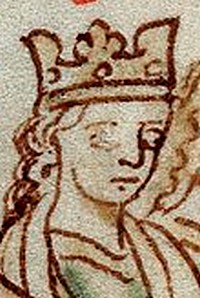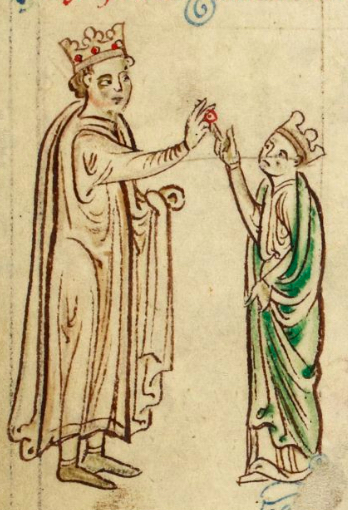by Susan Flantzer © Unofficial Royalty 2014

Eleanor of Provence, wife of King Henry III of England; Credit – Wikipedia
Eleanor of Provence was born circa 1223 in Aix-en-Provence, the capital of the County of Provence, now in France. Her parents were Ramon Berenguer IV, Count of Provence and Beatrice of Savoy. The couple had two stillborn sons, but their four beautiful daughters made excellent marriages and were all queens via these marriages.
- Margaret of Provence (1221–1295), wife of King (Saint) Louis IX of France
- Eleanor of Provence (1223–1291), wife of King Henry III of England
- Sanchia of Provence (1228–1261), wife of Richard, Earl of Cornwall, King of the Romans, son of King John of England and brother of King Henry III of England
- Beatrice of Provence (1231–1267), wife of King Charles I of Sicily
King Henry III of England was in marriage talks for the hand of Joan, Countess of Ponthieu when his brother Richard, Earl of Cornwall told him of the beauty of the Provence sisters. Henry immediately canceled his talks for Joan and made an offer to marry Eleanor of Provence. Eleanor traveled from Provence in the south of France to the court of King Louis IX of France to visit her sister Margaret, and then continued her journey to England, landing in Dover. On January 14, 1236, 28-year-old King Henry III and Eleanor, who was about 12 years old, were married at Canterbury Cathedral by Edmund Rich, Archbishop of Canterbury. Eleanor was crowned Queen of England at Westminster Abbey on January 20, 1236.
Despite the couple’s age difference, their marriage was a happy one. Henry had the Palace of Westminster refurbished for his bride, gave her a number of gifts, and paid personal attention to establishing and equipping Eleanor’s household. King Henry III was greatly devoted to Edward the Confessor and had adopted him as his patron saint. Eleanor became equally devoted to the saint and their first child was named for Edward the Confessor.
Henry and Eleanor had five children:
- King Edward I of England (1239–1307), married (1) Eleanor of Castile, had issue (2) Margaret of France, had issue
- Margaret, Queen of Scots (1240–1275), married King Alexander III of Scotland, had issue
- Beatrice, Countess of Richmond (1242–1275), married John II, Duke of Brittany, had issue
- Edmund Crouchback, 1st Earl of Lancaster (1245–1296), married (1) Aveline de Forz, no issue (2) Blanche of Artois, had issue
- Katherine of England (1253 – 1257), died at age 3

King Henry III and Eleanor of Provence; Credit – Wikipedia
As a young queen, Eleanor was admired by the English. However, this admiration eventually turned to annoyance and then rebellion when it was realized how many uncles and cousins from her mother’s side of the family Eleanor had brought with her. Her uncle William of Savoy became a close advisor of her husband, displacing and displeasing English barons. Taxes were increased due to Eleanor’s extravagance and her financial support and gifts to her friends and family. Eventually, King Henry III’s demands for extra finances and dissatisfaction with Henry’s methods of government caused the Second Baron’s War (1264-1267), a civil war between the forces of the barons led by Simon de Montfort, against the royalist forces led by Prince Edward (later King Edward I of England), in the name of King Henry III. After a three-year war, the royalist forces were victorious. Simon de Monfort, who was married to Eleanor, King Henry III’s sister, was defeated and brutally killed at the Battle of Evesham.
King Henry III died in 1272 at the age of 65, after a 56-year reign, making him the fourth longest-reigning British monarch after Queen Elizabeth II, Queen Victoria, and King George III. Eleanor survived her husband for 19 years and helped raise several of her grandchildren. In 1280, Eleanor retired to Amesbury Priory, a Benedictine monastery at Amesbury, Wiltshire, England where she died on June 24/25, 1291. It appears that Eleanor requested that she be buried with her husband at Westminster Abbey, but was buried at the Amesbury Priory where she had died. Eleanor’s remains were lost when the Abbey was destroyed in 1539 during the Dissolution of the Monasteries. Her heart was buried at London’s Greyfriars Monastery which was destroyed in the Great Fire of London in 1666.
This article is the intellectual property of Unofficial Royalty and is NOT TO BE COPIED, EDITED, OR POSTED IN ANY FORM ON ANOTHER WEBSITE under any circumstances. It is permissible to use a link that directs to Unofficial Royalty.
England: House of Plantagenet Resources at Unofficial Royalty
- United Kingdom of Great Britain and Northern Ireland Index
- House of Plantagenet Index (1216 – 1399)
- British Royal Births, Marriages, Deaths, and Other Important Events
- Coronations after the Norman Conquest (1066 – present)
- History and Traditions: Norman and Plantagenet Weddings
- House of Plantagenet Burial Sites
